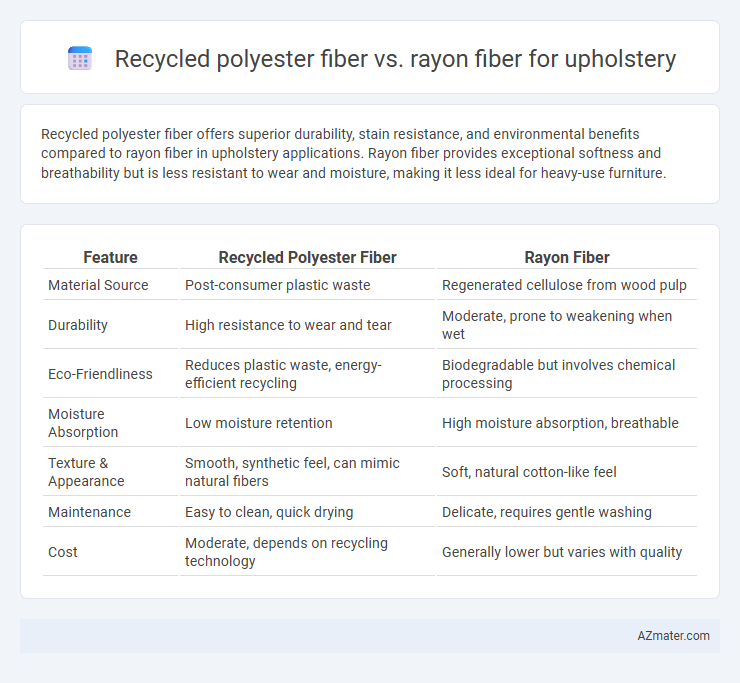Recycled polyester fiber offers superior durability, stain resistance, and environmental benefits compared to rayon fiber in upholstery applications. Rayon fiber provides exceptional softness and breathability but is less resistant to wear and moisture, making it less ideal for heavy-use furniture.
Table of Comparison
| Feature | Recycled Polyester Fiber | Rayon Fiber |
|---|---|---|
| Material Source | Post-consumer plastic waste | Regenerated cellulose from wood pulp |
| Durability | High resistance to wear and tear | Moderate, prone to weakening when wet |
| Eco-Friendliness | Reduces plastic waste, energy-efficient recycling | Biodegradable but involves chemical processing |
| Moisture Absorption | Low moisture retention | High moisture absorption, breathable |
| Texture & Appearance | Smooth, synthetic feel, can mimic natural fibers | Soft, natural cotton-like feel |
| Maintenance | Easy to clean, quick drying | Delicate, requires gentle washing |
| Cost | Moderate, depends on recycling technology | Generally lower but varies with quality |
Introduction: Recycled Polyester vs Rayon in Upholstery
Recycled polyester fiber offers superior durability and stain resistance compared to rayon fiber, making it a popular choice for upholstery in high-traffic areas. Rayon fiber, derived from natural cellulose, provides a soft and breathable texture but typically lacks the resilience and moisture-wicking properties of recycled polyester. The environmental benefits of recycled polyester include reduced plastic waste and lower carbon emissions, whereas rayon production involves chemical processing of wood pulp, impacting sustainability considerations.
Understanding Recycled Polyester Fiber
Recycled polyester fiber, made from reclaimed plastic bottles and industrial polyester waste, offers enhanced durability, stain resistance, and color retention, making it an eco-friendly option for upholstery. This fiber reduces landfill waste and energy consumption during production compared to virgin polyester, contributing to sustainable textile practices. Its moisture-wicking properties and resilience under heavy use distinguish recycled polyester as a preferable alternative to rayon fiber, which is less durable and more prone to water damage in upholstery applications.
What is Rayon Fiber?
Rayon fiber, a semi-synthetic cellulose-based material derived from wood pulp, offers a soft texture and excellent drapability ideal for upholstery fabrics. It absorbs moisture well, enhancing comfort but making it prone to shrinking and wrinkles compared to recycled polyester fiber, which boasts superior durability and stain resistance. Unlike recycled polyester fiber made from post-consumer plastic waste, rayon's natural origin supports breathability but requires careful maintenance to prevent damage in high-use furniture.
Environmental Impact: Recycled Polyester vs Rayon
Recycled polyester fiber for upholstery significantly reduces environmental impact by utilizing post-consumer plastic waste, lowering greenhouse gas emissions and energy consumption compared to virgin polyester production. Rayon fiber, derived from cellulose, involves intensive chemical processing and high water usage, leading to deforestation and pollution concerns. Choosing recycled polyester minimizes resource depletion and toxic discharge, making it a more sustainable option than conventional rayon for upholstery applications.
Durability and Performance Comparison
Recycled polyester fiber exhibits superior durability compared to rayon fiber in upholstery, offering enhanced resistance to abrasion, stretching, and shrinking. This synthetic fiber maintains color vibrancy and structural integrity over extended use, making it ideal for high-traffic furniture applications. In contrast, rayon fiber tends to wear out faster due to its weaker moisture resistance and lower tensile strength, resulting in reduced longevity and performance.
Comfort and Texture Differences
Recycled polyester fiber offers durability and resistance to wrinkles and stains, providing a smooth and slightly crisp texture ideal for high-traffic upholstery. Rayon fiber delivers a softer, more breathable feel with a natural luster, enhancing comfort but with less durability compared to recycled polyester. Upholstery made from rayon tends to feel cooler and more comfortable in warm climates, while recycled polyester supports better long-term resilience in everyday use.
Stain Resistance and Maintenance
Recycled polyester fiber is highly favored for upholstery due to its superior stain resistance and easy maintenance, as it repels liquids and can be cleaned with mild detergents without losing durability. Rayon fiber, while soft and visually appealing, is more prone to staining and typically requires professional cleaning to avoid damage and maintain fabric integrity. Upholstery made from recycled polyester offers a practical, low-maintenance solution, making it ideal for high-traffic areas where stain resistance is critical.
Cost Efficiency for Upholstery Projects
Recycled polyester fiber offers superior cost efficiency for upholstery projects due to its lower material and production costs compared to rayon fiber. Its durability and resistance to shrinkage reduce long-term maintenance and replacement expenses, making it a budget-friendly option. Rayon fiber, while often softer, typically incurs higher costs because of its more complex manufacturing process and less durable performance in heavy-use furniture.
Style and Aesthetic Considerations
Recycled polyester fiber offers a durable, wrinkle-resistant finish with vibrant color retention, making it ideal for modern, sleek upholstery styles. Rayon fiber provides a soft, luxurious feel with a natural sheen that enhances traditional and vintage aesthetics, though it requires careful maintenance to prevent wear. Choosing between these fibers depends on desired texture and long-term visual appeal, with recycled polyester favoring practicality and rayon emphasizing elegance.
Choosing the Best Fiber for Upholstery Needs
Recycled polyester fiber offers superior durability, stain resistance, and eco-friendly benefits, making it ideal for high-traffic upholstery in homes and commercial spaces. Rayon fiber provides a soft, luxurious feel with excellent breathability but is less resistant to wear and moisture, requiring more maintenance in upholstery applications. Choosing the best fiber depends on prioritizing sustainability and durability with recycled polyester or opting for comfort and aesthetic appeal with rayon.

Infographic: Recycled polyester fiber vs Rayon fiber for Upholstery
 azmater.com
azmater.com